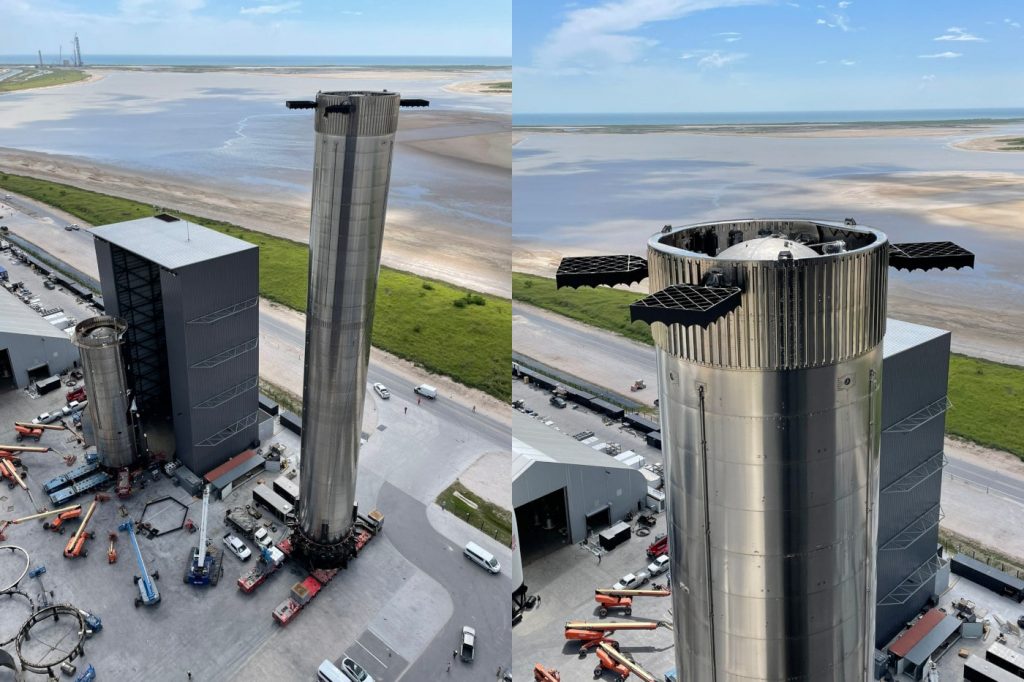
SpaceX deploys a giant rocket to power a spacecraft
after success Starship’s first high-altitude test flight, completed in May, led by the aerospace company Elon Musk He is preparing to send his ship into orbit. The first prototype of the Super Heavy, a super-heavy launcher designed specifically for this maneuver, has been set up on its launch pad, as evidenced by photos posted by Elon Musk. on his Twitter account.
Photos and videos shared by the CEO this week show the transfer of the ‘Booster 4’ propulsion engine to the orbital launch medium for SpaceX. Over the past weekend, engineers installed 29 impressive Raptor engines at the base of this rocket, about 70 meters high and 9 meters in diameter. On top of the spacecraft, the machine will reach a total height of about 120 meters.
So far, the Starship has only made flights at high altitudes, not exceeding ten kilometers. This time it will take it to a low orbit, several hundred kilometers away, which would require a much larger thrust – an estimated 72 MN According to SpaceX – from that carried out during previous test flights (the spacecraft was then powered by three Raptor engines, optimized for air flight).
Ultra fast build
The speed with which SpaceX projects advance is often astonishing. Prototype development for Booster 4 is another example. The company’s engineers installed 29 engines in the machine base in record time, almost overnight (note that 33 engines were planned for the final configuration). Super Heavy can now be found at the launch site.

Now the company has to carry out several technical tests of the launcher (in particular, pressure and fire resistance tests), which will undoubtedly be very comprehensive given the power of this missile. At the same time, SpaceX has almost completed the construction of the S20, the last prototype of the Starship, which will be put on the operator in order to obtain the full Starship system. As a reminder, the latter will be completely reusable, which will significantly reduce launch costs; So the machine is doomed to replace all SpaceX spacecraft.
According to the document filed with Federal Communications Commission, the first orbital flight is expected to take about 90 minutes: The craft and spacecraft should separate about 170 seconds after liftoff, then Super Heavy will attempt to land in the Gulf of Mexico. The spacecraft is expected to continue its orbital journey, eventually landing “quietly” about 100 kilometers off the northwest coast of Kauai, in the Hawaiian archipelago.
Clearly, SpaceX has worked hard to speed up development of its ultra-heavy launcher and thus be able to test-launch the spacecraft as soon as possible. But before that, the project must pass the evaluation exam of Federal Aviation Administration (FAA), which aims to determine whether the company’s orbital launch facilities Complies with environmental standards. This review is obviously based on approval of test flights.
Environmental impact can delay launch
The Federal Aviation Administration (FAA) completed an environmental assessment for the area in 2014, but that review was for the SpaceX Falcon series of rockets, much smaller than the vehicle the company is building today. FAA spokesperson So he warned last month that “environmental review may recommend dismantling the launch tower”.
So the action will undoubtedly be sensitive, especially since relations between SpaceX and the regulator are somewhat strained; In fact, on several occasions, Elon Musk’s company has begun prototype tests even before getting the go-ahead from the FAA… Plus, once a draft of this evaluation is published, it will be open for public comment for a minimum of 30 days. Only at the end of this period will the FAA decide whether or not additional work is necessary for the site to comply with environmental standards.
Finally, there is little chance that the FAA will give the go-ahead for the orbital flight before this fall, or even after. Will Elon Musk be able to wait this long? according to Ars TechnicaHowever, it appears that SpaceX is still hiring quite a few employees, then has asked hundreds of employees from its headquarters and other subsidiaries to join the Boca Chica site to complete the launch site installation and the Super Heavy assembly. By completing the Starship system as quickly as possible, Elon Musk may encourage the Federal Aviation Administration (FAA) to speed up the regulatory process—and that, with the support of NASA and the US Department of Defense, who certainly don’t want to see a “game.”» on the sidelines.

“Incurable web evangelist. Hipster-friendly gamer. Award-winning entrepreneur. Falls down a lot.”
